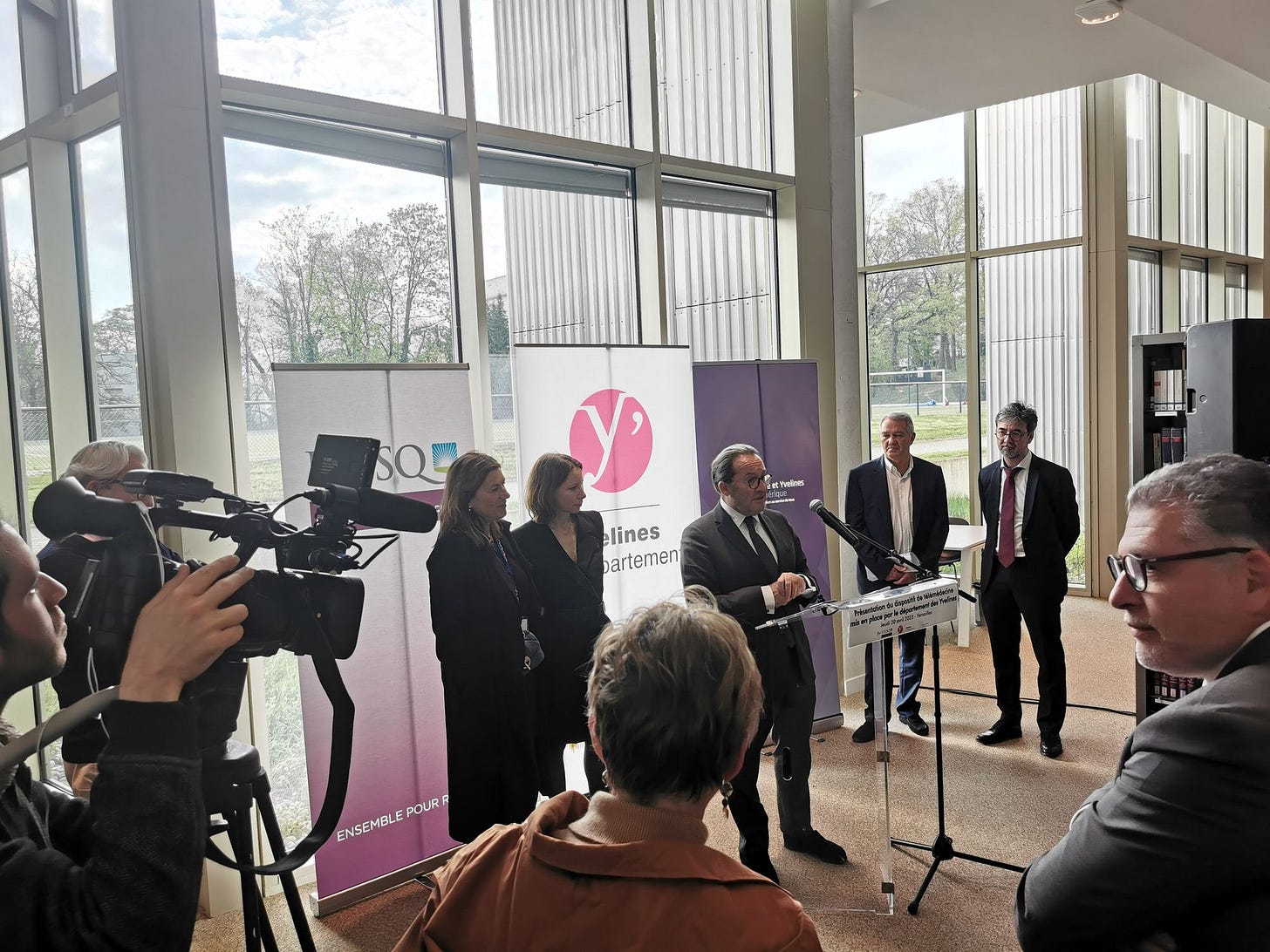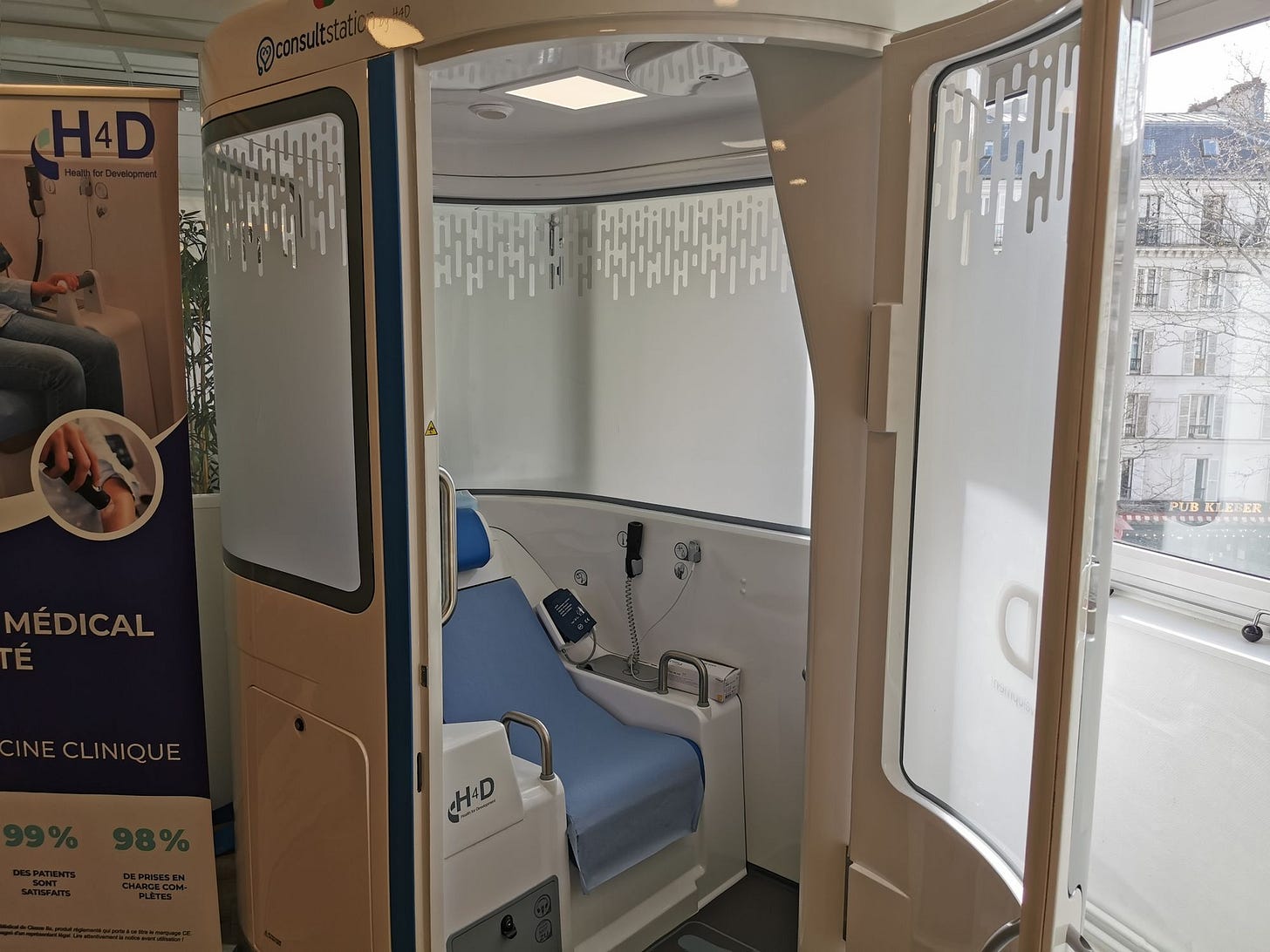Can Startups Solve France's Medical Desert Problem?
13% of the French population lives in a region without access to a primary care physician. With reform efforts stuck in neutral, the government is counting on startups to find innovative solutions.
Just to the west of Paris lies the sprawling Yvelines department where I happen to live. While it includes such upscale towns as Saint-Germain-en-Laye and Versailles, Yvelines is also characterized by a vast rural region.
On a late April evening, political and healthcare leaders of Yvelines gathered at the Université Paris Saclay campus in Versailles to address one of the most pressing issues facing Yvelines: A shocking decline in access to basic healthcare.
Over the past decade, Yvelines has lost 20% of its doctors, and another 40% are over 60 years old. Across the department, 15% of residents don't have an official general family doctor, a gap that widens in rural areas. Drive through small villages and one will see posters along the streets advertising the need for doctors. Despite the nation's renowned national health care system, this has become a crisis across France where 13% of the population now lives in a region the government officially defines as a "medical desert."
In the face of this deficiency, the Yvelines department in late 2022 made a call for telemedicine solutions that could address the problem immediately. On this night in Versailles, leaders officially announced they had signed a €10 million contract with Paris-based H4D to deploy 50 of its telemedicine cabins around the department, including one on a bus that would roam from town to town offering both general telemedicine appointments as well as specialized gynecological exams.
Yvelines Department President Pierre Bédier, speaking at the event, said that while the law doesn't necessarily charge local governments with providing health care in France, officials felt an urgent need to act. "The alarming situation pushed us to make this type of decision," he said.

The project represents a big gamble for Yvelines. But it also suggests the massive opportunity for H4D, both in terms of the potential business as well as the possibility to have a major impact on the daily lives of people across France.
"H4D's whole ambition is to fight against medical deserts," said CEO Valérie Cossutta.
A Medical Vision
Just a few weeks before the Yvelines announcement, I visited H4D's headquarters in Paris to chat with Cossutta. She has only recently been promoted to the CEO chair, replacing Dr. Franck Baudino who had founded the company more than a decade ago.
Baudino was an emergency room doctor who had worked in India and then Deauville, France. Over time, he simply had too many patients to see in person, and yet he worried that contacting them remotely by phone would result in substandard care. He asked himself a simple question: "How can I have the same thing as in my medical practice, but at a distance?"
He recruited some engineering friends who helped build the first version of what has become H4D's core concept: A telemedicine booth. The cabin now includes 15 connected medical devices and a video screen for a live remote consultation with a doctor.
During my visit, I took the main model for a test drive. I entered the booth (shown in the main photo above) and sat in the chair. The patient inserts their national health card in a slot and then the session begins.
The consultation is a combination of automation and human interaction. Inside the cabin, there are connected devices that are versions of the devices one would find in the office of any general physician for a general check-up to check vitals such as blood pressure, heartbeat, blood oxygen level, height/weight/BMI, temperature, vision, hearing, and dermatology.
Perhaps the trickiest part of the whole operation was when I needed to attach a tongue depressor to a camera and then position it in my mouth in just the right way so the remote doctor on the screen could see down my throat. He gently encouraged me to tilt my head, raise the camera, and adjust the tongue depressor, until he had a clear view.
In all, it was quick and efficient. The cabin is equipped with a small printer to print a prescription. If there are any red flags, the patient is encouraged to make a follow-up in-person appointment. The data is uploaded to an online patient account where it can be shared with another doctor.
"The idea is to put the patient at ease," Cossutta said. "The ergonomics of the cabin are designed so you can look at your patient from head to toe so that the doctor can detect the most serious causes as well as the simplest ones."
H4D now has three versions of the telemedicine cabin. There is the larger, fully-equipped version that I tried. There is a mid-sized one. And more recently, they have launched a third-smaller and more mobile version called CS Open. The latter is a stand-up version that can be rolled away or installed in a smaller space.
H4D has spent the past decade refining the whole design and software that powers the cabins. Getting the patient in just the right position so they are comfortable, with just the right access to the diagnostic equipment, and the software that efficiently captures information in real-time so the doctor can respond quickly.
During that process, H4D obtained European approval for its cabins to be used as official medical devices. Though much of its business is still focused on France, it now has cabins in Italy, Portugal, Estonia, Gabon, and the UK.
Along the way, H4D has raised three rounds of venture capital. After an initial early investment for an undisclosed amount by the Luxemburg family office Atoga, H4D raised €6.7 million in 2016 from Innovation Capital, Bpifrance et CNP Assurances. In June 2020, the company raised €15 million from previous investors plus Aviva France, LBO France, and Supernova Invest.
H4D does sell its cabins to private companies, including SNCF, Axa, Airbus, and EDF. But it's the public market, faced with the medical desert challenge, where the company has really started to get traction.
"My strategy is really to consolidate our presence in France," Cossutta said. "Particularly the local authority market."
Many of those partnerships have taken the form of anywhere from one telemedicine cabin in a city hall to a few cabins in a village. But more recently those deals have grown in size as two larger departments have begun to expand their use of the telemedicine cabins.
Digital Health Divide
As with so many other digital health services, H4D got a boost from the pandemic as local governments began to look at alternative health solutions. While France had been behind in embracing digital health tools, Covid changed that radically.
According to French government statistics, virtual health visits rose from 127,000 in 2019 to 18.5 million in 2020. That number fell back to 12 million in 2021 as many travel restrictions were lifted. Still, it's clear that telemedicine visits had become a daily feature of the medical profession in France.
However, a study by Health Data Hub found that these online telemedicine platforms were not having a big impact on medical deserts. According to the study, telemedicine patients tended to be young and live in bigger cities while the lowest rates of use were in rural departments. For example, only 2.3% of the population in the rural Creuse département had a virtual medical appointment in contrast to 17% in Paris.



